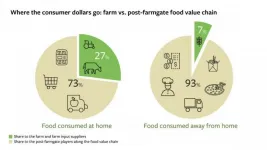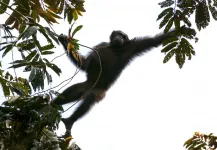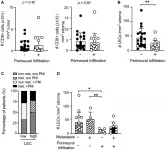(Press-News.org) The threat of antibiotic resistance rises as bacteria continue to evolve to foil even the most powerful modern drug treatments. By 2050, antibiotic resistant-bacteria threaten to claim more than 10 million lives as existing therapies prove ineffective.
Bacteriophage, or "phage," have become a new source of hope against growing antibiotic resistance. Ignored for decades by western science, phages have become the subject of increasing research attention due to their capability to infect and kill bacterial threats.
A new project led by University of California San Diego Biological Sciences graduate student Joshua Borin, a member of Associate Professor Justin Meyer's laboratory, has provided evidence that phages that undergo special evolutionary training increase their capacity to subdue bacteria. Like a boxer in training ahead of a title bout, pre-trained phages demonstrated they could delay the onset of bacterial resistance.
The study, which included contributions from researchers at the University of Haifa in Israel and the University of Texas at Austin, is published June 8 in the Proceedings of the National Academy of Sciences.
"Antibiotic resistance is inherently an evolutionary problem, so this paper describes a possible new solution as we run out of antibiotic drug options," said Borin. "Using bacterial viruses that can adapt and evolve to the host bacteria that we want them to infect and kill is an old idea that is being revived. It's the idea of the enemy of our enemy is our friend."
The idea of using phages to combat bacterial infections goes back to the days prior to World War II. But as antibiotic drugs became the leading treatment for bacterial infections, phage research for therapeutic potential was largely forgotten. That mindset has changed in recent years as deadly bacteria continue to evolve to render many modern drugs ineffective.
Borin's project was designed to train specialized phage to fight bacteria before they encounter their ultimate bacterial target. The study, conducted in laboratory flasks, demonstrated classic evolutionary and adaptational mechanisms at play. The bacteria, Meyer said, predictably moved to counter the phage attack. The difference was in preparation. Phages trained for 28 days, the study showed, were able to suppress bacteria 1,000 times more effectively and three- to eight-times longer than untrained phage.
"The trained phage had already experienced ways that the bacteria would try to dodge it," said Meyer. "It had 'learned' in a genetic sense. It had already evolved mutations to help it counteract those moves that the bacteria were taking. We are using phage's own improvement algorithm, evolution by natural selection, to regain its therapeutic potential and solve the problem of bacteria evolving resistance to yet another therapy."
The researchers are now extending their findings to research how pre-trained phages perform on bacteria important in clinical settings, such as E. coli. They are also working to evaluate how well training methods work in animal models.
UC San Diego is a leader in phage research and clinical applications. In 2018 the university's School of Medicine established the Center for Innovative Phage Applications and Therapeutics, the first dedicated phage therapy center in North America.
"We have prioritized antibiotics since they were developed and now that they are becoming less and less useful people are looking back to phage to use as therapeutics," said Meyer. "More of us are looking into actually running the experiments necessary to understand the types of procedures and processes that can improve phage therapeutics."
INFORMATION:
The study's full author list includes: Joshua Borin, Sarit Avrani, Jeffrey Barrick, Katherine Petrie and Justin Meyer.
To investigate factors that can jeopardize pregnancy success in cattle, researchers at the University of São Paulo (USP) in Brazil used a kind of chip to mimic the environment of the endometrium, the tissue that lines the inside of the uterus.
The study was conducted by biologist Tiago Henrique Camara de Bem, a postdoctoral fellow at the University of São Paulo's School of Animal Science and Food Engineering (FZEA-USP), in collaboration with four researchers at the University of Leeds in the UK. Their findings are reported in an article in the journal Endocrinology.
The researchers focused on analyzing alterations in levels of insulin and glucose in maternal ...
CAMBRIDGE, MA -- About 60 percent of drugs on the market have hydrophobic molecules as their active ingredients. These drugs, which are not soluble in water, can be difficult to formulate into tablets because they need to be broken down into very small crystals in order to be absorbed by the human body.
A team of MIT chemical engineers has now devised a simpler process for incorporating hydrophobic drugs into tablets or other drug formulations such as capsules and thin films. Their technique, which involves creating an emulsion of the drug and then crystallizing it, allows for a more powerful dose to be loaded per tablet.
"This is very important because if we can achieve high drug loading, it means that we can ...
ITHACA, N.Y. - As soon as an ear of corn is taken off its stalk or a potato is pulled from the ground, it travels anywhere from a few miles to across continents and sometimes undergoes processes that transform it into the food we consume.
These miles and processes contribute to what's known as the food value chain (FVC), along which, as one might expect, the value of the product increases. However, most of the research and attention thus far paid to FVCs occurs at the ends of the chain - inside the farm gate and at the consumer's plate.
Less is understood about all of the other links in the FVC, in part due to a lack of ...
Oncotarget published "Landscape of somatic mutations in breast cancer: new opportunities for targeted therapies in Saudi Arabian patients" which reported that the association between genetic polymorphisms in tumor suppressor genes and the risk of BCa has been studied in many ethnic populations with conflicting conclusions while Arab females and Saudi Arabian studies are still lacking.
The authors screened a cohort of Saudi BCa patients by NGS using a bespoke gene panel to clarify the genetic landscape of this population, correlating and assessing genetic ...
In the quest for healthy aging and longer lifespan, Danish researchers at the University of Southern Denmark have collaborated with Swedish researchers at Karolinska Institutet to explore the anti-aging effects of football and team handball training in women.
In a current study published in Scientific Reports, the researchers investigated the effects of lifelong regular exercise on two of the central hallmarks of aging combined and showed that football and team handball have a positive effect on telomere length and mitochondrial function in women.
"Our legacy consists of DNA that is packed in chromosomes. When cells divide, the inheritance is copied, but with each cell division the ends of the DNA threads get shorter. The so-called telomeres are shortened, which causes us to age. ...
High blood pressure, or hypertension, is the leading modifiable risk factor for cardiovascular diseases and premature death worldwide. And key to treating patients with conditions ranging from chest pain to stroke is understanding the intricacies of how the cells around arteries and other blood vessels work to control blood pressure. While the importance of metals like potassium and calcium in this process are known, a new discovery about a critical and underappreciated role of another metal - zinc - offers a potential new pathway for therapies to treat hypertension.
The study results were published recently in Nature Communications.
All the body's functions depend on arteries channeling oxygen-rich ...
The COVID-19 pandemic continues to disrupt and end lives around the world, and public health officials worldwide have recognized vaccines as the critical tools required for controlling the COVID-19 death toll and achieving a return to normal life. Several vaccines against COVID-19 are already in use, but the limited supplies of these vaccines and the possibility of safety and efficacy issues of the existing vaccines mean that it is important for scientists to develop more (and even better) vaccines. In fact, as of February 2021, 69 different vaccines are in various phases of clinical development.
One type of vaccine that could prove quite useful is the inactivated vaccine, which contains an inactivated form of the virus. The inactivated virus cannot harm the recipient, but ...
A new study published in the journal Diversity and Distributions predicts massive range declines of Africa's great apes - gorillas, chimpanzees and bonobos - due to the impacts of climate change, land-use changes and human population growth.
For their analysis, the authors compiled information on African ape occurrence held in the IUCN SSC A.P.E.S. database, a repository that includes a remarkable amount of information on population status, threats and conservation for several hundred sites, collected over 20 years.
The first-of-its-kind study quantifies the joint effects of climate, land-use, and human population changes across African ape ranges for the year ...
Oncotarget published "Effect of cell microenvironment on the drug sensitivity of hepatocellular cancer cells" which reported that this study aimed to investigate whether Hepatocellular Cancer (HCC) cells cultured in more native conditions have an altered phenotype and drug sensitivity compared to those cultured in standard conditions.
Six HCC cell lines were cultured in "standard" or more "native" conditions.
HCC cells cultured in native conditions had slower doubling times, increased HK2 and GLUT, lower PHDA and ATP levels, and mutations in mitochondrial DNA.
From 90 comparisons of drug sensitivity, increased resistance ...
Oncotarget published "Mutually exclusive lymphangiogenesis or perineural infiltration in human skin squamous-cell carcinoma" which reported that although tumor-associated lymphangiogenesis correlates with metastasis and poor prognosis in several cancers, it also supports T cell infiltration into the tumor and predicts favorable outcome to immunotherapy.
Using quantitative multiplex immunohistochemistry, the authors analyzed skin squamous-cell carcinoma (sSCC) sections from 36 patients.
CD8 T cell infiltration showed great differences between patients, whereby these ...









